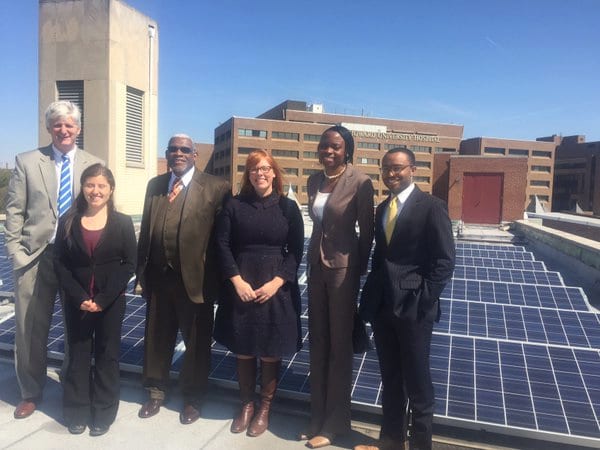America’s Cities Are ‘Shining’ Says New Report
Thursday, Apr 07 2016
By
Comms Team

(Left to right) SEIA Vice President of Communications Dan Whitten; Environment America Fellow Lindsey Mendelson; Senior Pastor Earl D. Trent Jr; and District of Columbia Department of Energy and Environment Deputy Director of Energy Teresa Lawrence and Program Analyst Emil King stand in front of the solar system atop Florida Avenue Baptist Church in Washington, D.C.
A report unveiled Wednesday shows that America’s cities are taking solar seriously.
Shining Cities 2016: How Smart Local Policies Are Expanding Solar Power in America, co-authored by Environment America and the Frontier Group, ranks cities by total solar photovoltaic (PV) capacity installed and PV capacity per capita at the end of 2015, and provides policy recommendations for the federal, state and local governments that can spur solar deployments in the future.
Topping the list in total PV capacity were Los Angeles, San Diego and Phoenix while the cities with the most PV installed per person were Honolulu, Indianapolis and San Jose. The 64 cities included in the report deployed over 1.7 gigawatts (GW) of PV capacity combined, approximately the amount of solar power installed across the entire country at the end of 2010.
“Thanks to forward-thinking policies and the vision of local government leaders, these cities really shine when it comes to solar power," said Bret Fanshaw, solar program coordinator with Environment America and the report's co-author.
Events for the report’s release are being held in shining cities across America this week. In Washington, D.C., which ranks second for solar-powered cities in the South Atlantic region, Environment America hosted a press conference at Florida Avenue Baptist Church, which boasts a 10.5 kilowatt (KW) rooftop solar system, saving the church over $600 a month on its electric bill.
SEIA's @DanWhitten helping celebrate #DC's new @EnvAm ranking as #2 in the south Atlantic for #solar #shiningcities pic.twitter.com/DChh383td3
— Solar Industry (@SEIA) April 6, 2016
"With burgeoning demand for solar and smart policies, communities across America are seeing massive benefits in the form of cleaner air, skyrocketing tax revenues and well-paying jobs,” said Dan Whitten, vice president of communications for SEIA. “We are pleased that Washington is a leading player in the solar revolution in the South Atlantic region."
Solar’s metropolitan boom is encouraging, and there’s still incredible room to grow according to a National Renewable Energy Laboratory study. Los Angeles, which leads cities with 215 megawatts (MW) of solar capacity deployed, could install up to 9,000 MW of solar capacity on its rooftops. Chicago, San Antonio and New York could each install over 6,000 MW on its rooftops while nine other cities could each accommodate at least 2,000 MW of capacity.
Article Type